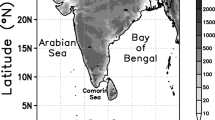Abstract
A very severe cyclonic storm “Aila” hit West Bengal on 26 May 2009. The storm intensified when it encountered with a warm core (SST = 31°C) anti-cyclonic eddy (ACE4) in the north Bay of Bengal. The storm intensity increased by 43% due to this eddy, which is comparable with that (34%) obtained from a best fit line (derived from several numerical experiments over north-west Pacific Ocean). The shallow mixed layer of the large-scale ocean and deep mixed layer inside the eddy appear to be crucial parameters besides translation speed of the storm (Uh), ambient relative humidity and thermal stratification below mixed layer, in the storm intensification. From the eddy size and Uh, the eddy feedback factor is found to be about 0.4 (i.e. 40%), which is close to the above. Since there exists an inverse relationship between Uh and UOHC (upper ocean heat content), slow (fast) moving storms require high (low) UOHC. The warm ACE4 with a high UOHC of 149 kj/cm2 (300% higher than the climatological value) and deep warm layer (D26 = 126 m) opposes the cooling induced by the storm and helps for the intensification of the storm through the supply of large enthalpy (latent + sensible) flux.






Similar content being viewed by others
References
Ali MM, Sharma R, Cheney R (1998) An atlas of the north Indian Ocean eddies from TOPEX altimeter derived sea surface heights. Spec Publ ISRO-SAC, SP, 69–98, Indian Space Res Org, Bangalore, India
Ali MM, Jagadish PSV, Jain S (2007) Effect of eddies on Bay of Bengal cyclone intensity. EOS Trans AGU 88(8). doi:10.1029/2007EO08001
Behringer DW, Xue Y (2004) Evaluation of the global ocean data assimilation system at NCEP: the Pacific Ocean. Eighth symposium on integrated observing and assimilation systems for atmosphere, oceans, and land surface, AMS 84th annual meeting, Washington State Convention and Trade Center, Seattle, Washington, 11–15
Goni GJ, Trinanes JA (2003) Ocean thermal structure monitoring could aid in the intensity forecast of tropical cyclone. EOS Trans AGU 84(51). doi:10.1029/2003EO510001
Gopalan AKS, Gopala Krishna VV, Ali MM, Sharma R (2000) Detection of Bay of Bengal eddies from TOPEX and in situ observations. J Mar Res 58:721–734
Kotal SD, Roy Bhowmik RSK, Kundu PK (2008) Application of statistical-dynamical scheme for real time forecasting of the Bay of Bengal very severe cyclonic storm “Sidr” of November 2007. Geofizika 25(2):139–158
Lin I-I, Wu CC, Emmanuel KA, Lee IH, Wu CR, Pun IF (2005) The interaction of super typhoon Maemi (2003) with a warm ocean eddy. Mon Wea Rev 133:2635–2649
Lin I-I, Wu CC, Pun IF (2008) Upper ocean thermal structure and the western North Pacific category 5 typhoons, Part I: Ocean features and category 5 Typhoon’s intensification. Mon Wea Rev 136:3288–3306
Lin I-I, Pun IF, Wu CC (2009a) Upper ocean thermal structure and the Western north Pacific category 5 Typhoons. Part II: dependence on translation speed. Mon Wea Rev 137:3744–3757
Lin I-I, Chen CH, Pun IF, Liu WT, Wu CC (2009b) Warm ocean anomaly, Air-sea fluxes and the rapid intensification of tropical cyclone Nargis, 2008. Geophys Res Letts 36:LO3817. doi:10.1029/2008GL035815
McPhaden MJ, Foltz GR, Lee T, Murty VSN, Ravindran M, Vecchi GA, Vialard J, Wiggert JD, Yu L (2009) Ocean-atmosphere interactions during cyclone Nargis. EOS Trans 90(7):53–60
Murthy VSN, Guptha GVM, Sarma VV, Rao BP, Jyothi D, Shastri PNM, Supraveena Y (2000) Effect of vertical stability, circulation on the depth of chlorophyll maximum in the Bay of Bengal during May–June, 1996. Deep Sea Res 47(5):103–117
Sadhuram Y, Rao BP, Shastri PNM, Subrahmanyam MV (2004) Seasonal variability of cyclone heat potential in the Bay of Bengal. Nat Hazards 32:191–209
Sadhuram Y, Ramana Murty TV, Somayajulu YK (2006) Estimation of cyclone heat potential in the Bay of Bengal and it’s role in the genesis and intensification of the storms in Bay of Bengal. Ind J Mar Sci 35(2):132–138
Sadhuram Y, Maneesha K, Ramana Murthy TV (2010) Importance of upper Ocean heat content in the intensification and translation speed of cyclones over the Bay of Bengal. Curr Sci 99(9):1191–1194
Scharroo R, Smith WHF, Lillibridge JL (2005) Satellite altimetry and the intensification of hurricane Katrina. EOS Trans Amer Geophys Union 86:366–367
Shay LK, Goni GJ, Black PG (2000) Effects of warm oceanic feature on hurricane Opal. Mon Wea Rev 128:1366–1383
Subrahmanyam B, Murty VSN, Sharp RJ, Obrien JJ (2005) Air-sea coupling during the tropical cyclones in the Indian Ocean: a case study using satellite observations. Pure Appl Geophys 162:1643–1672
Sujatha P, Mohanthy UC (2008) A comparative study on performance of MM5 and WRF models in simulation of tropical cyclones over Indian seas. Curr Sci 95(7):923–936
Wu CC, Lee CY, Lin I-I (2007) The effect of the Ocean eddy on tropical cyclone intensity. J Atmos Sci 64:3562–3578
Acknowledgments
The authors would like to thank Dr. S. R. Shetye, Director, N.I.O. and Dr. V. S. N. Murty, Scientist-in-Charge, NIO, Regional centre, Visakhapatnam (CSIR, New Delhi), for their support and encouragement. Mrs. Maneesha is thankful to CSIR (Council for Scientific and Industrial Research), New Delhi, for providing the Senior Research Fellowship (SRF). Thanks to all the project teams for making the data sets (SSHA,TMI SST, Argo data, RAMA buoys data, monthly mean vertical temperature profiles) available on the websites. The authors are thankful to the anonymous reviewers for their valuable suggestions, which helped to improve the original version of the manuscript. This is NIO contribution number 4969.
Author information
Authors and Affiliations
Corresponding author
Rights and permissions
About this article
Cite this article
Sadhuram, Y., Maneesha, K. & Ramana Murty, T.V. Intensification of Aila (May 2009) due to a warm core eddy in the north Bay of Bengal. Nat Hazards 63, 1515–1525 (2012). https://doi.org/10.1007/s11069-011-9837-1
Received:
Accepted:
Published:
Issue Date:
DOI: https://doi.org/10.1007/s11069-011-9837-1




